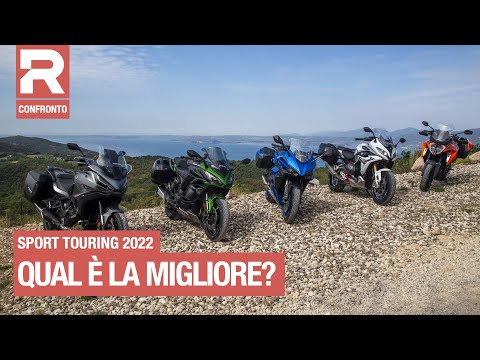A confronto le migliori Sport Touring sul mercato BMW, Honda, Kawasaki, KTM, Suzuki

Sport Touring. Two simple words that sound as clashing terms. "Is it truly possible to combine sporty character with tourist vocation in a single bike"? Today, when I think of crossovers it is easy for me to reply “Yes, it is”, but once this feature belonged to other bikes... I mean, road bikes with fairings, sporty bikes easy to ride, capable of reaching the North Cape and being enjoyable on the mountain passes at the same time.
They are no longer the travelling queens. That’s fine... but there are still those who can’t resist their charm and since when we test them many of you ask to compare them as well... So, we decide to make you happy.
Welcome to our sport touring bikes comparison. Enjoy! As usual, in our comparisons we prefer not to adopt original equipment tyres (OEM). A truly heavy variable... So, for this reason we adopt the same tyre for all our bikes. In this regard, the protagonist of our comparison to me represents one of the most interesting and valuable element within the sport touring segment. I mean, the latest release of Metzeler’s Roadtec 01 SE.
I won’t dive into technical details because we have already talked about these tyres many times... (see all the info in our “description” section). What's really interesting is that this comparison gave us the chance to try this tyre in different sizes. Except for the front 120/70, adopted by all the motorcycles of our comparison; about the rear tyre instead here we have a wide spectrum of sizes: 190/50 used by Kawasaki and Suzuki, 190/55 mounted by KTM Super Duke GT and 180/55 adopted by Honda NT 1100 and BMW R 1250 RS. I believe the adoption of these type of tyres further enhanced both riding pleasure and handling.
To me, the Metzeler’s Roadtec 01 SE are truly brilliant tyres, which allowed a super-fast warm-up time, a very good balance between front and rear both with 180/55 and 190/55. With the 190/50, a somewhat particular and “old” tyre, that usually leans on the rear, with the Roadtec it disappears. And the proof is that the two bikes fitted with this tyre have improved a lot in terms of rideability. I detected no problems in terms of grip, and I also add an excellent comfort level of the carcasses... So, this is a premium element, suitable for bikes like the ones we are going to test and which has certainly increased the level of riding pleasure of all the bikes in our comparison. BMW R 1250 RS, a motorcycle born from the Munich-based manufacturer’s passion for the sport touring segment.
The acronym stands for RennSport (Racing Sport) and embellishes the sides of this model for several decades and what’s more, some years ago it distinguished motorcycles derived from racing models. Today, the RS model is a motorcycle designed for long-distance trips but behind it a bit of sportiness has been maintained, as one can see from the upside-down fork, a kind of unique choice on modern BMWs featuring the boxer engine from the German manufacturer. Introducing the 2-cylinder boxer engine with 1.254 cc and ShiftCam technology, 135 hp and 143 Nm of torque. The fuel tank has a capacity of 18 litres, the saddle is 820 mm from the ground all packed in 266,4 kg. The side cases are almost perfectly symmetrical to each other, the right weighs 4,100 kg, the left 4; the overall dimensions are 102 cm.
The price? This model is available at 21,740 euros. Even for Kawasaki, the idea of sport touring is a distinctive trait. And the Ninja 1000SX represents the most classic example you could ask for. Full fairing, handlebar risers, and a nice 4-in-line engine.
The SX acronym has not always been married to the name Ninja; after all, until a few years ago the sport touring bikes par excellence from the Japanese manufacturer - ZZ R before and Z1000 after - and it's only with this latest model the SX acronym conquered the place it deserves. To me, this bike today has achieved its ultimate evolution. 142 hp and 111 Nm of torque not to mention a full suite of electronics: inertial platform, traction control, quick shifter, 4 engine maps, cruise control, and 4.3” all-digital TFT color instrumentation. What’s more, the fuel tank capacity is 19 litres, the saddle is positioned at 835 mm form the ground, all packed in 244,8 kg.
The side cases of 57 liters of capacity are symmetrical, weigh 3,86 each and have a footprint of 97 cm. The Kawasaki Ninja 1000SX is available at 15,540 euros. The KTM 1290 Super Duke GT joined our comparison with two precious numbers: 173 hp and 141 Nm of torque.
Among the main contenders the KTM 1290 Super Duke GT is certainly the most aggressive, as the taut lines drawn by the pencil of the historic design agency Kiska also suggest. The starting point is represented by the Super Duke R. It’s okay to travel but the important thing, in our opinion, is to inject adrenaline into the veins of the rider. The winning cards to make the Super Duke an authentic sports tourer, however, are many: adjustable windshield (9 positions), cruise control, 23 litres fuel tank, and side cases intended for travel, perfectly symmetrical and the lightest among others challengers. The weight stands at 244.2 kg and the saddle is 835 mm from the ground.
The Super Duke 1290 GT not only is the most powerful but is also available at a premium price… 21,789 euros. Sport Touring. While KTM fully reflects the sporty vocation, the Honda NT 1100 truly embodies the idea of touring. There’s no question: a quick glance will make you understand how the Japanese engineers, once again, have focused their attention on comfort, so much so as to make the NT appear as a tourer in all respects. When the subject is Honda, however, you must not take anything for granted.
In fact we are sure that the Honda NT will be able to stand out even among much more powerful bikes. 102 hp and 104 Nm of torque, which are not so far from the numbers of the other bikes of the comparison. We already know the engine truly well because the 1,084 cc in-line twin-cylinder, the only one of our comparison, is derived from the CRF1100L Africa Twin. What’s really grabs attention is its strong tourist vocation and the Honda’s sixspeed Dual Clutch Transmission (DCT) does the rest. The weight stands at 266.4 kg. The saddle is positioned at 820 mm from the ground while the side cases
weight 4,4 kg (right) and 4,5 (left). The Honda NT 1100 is available at 15,490 euros, the cheapest price of our test. In 2021 Suzuki decided to redesign the GSX S 1000 F and the result is this new GSX-S1000GT. The latter, together with BMW R 1250 RS and Kawasaki Ninja 1000SX, is the model that best come closest to the concept of Sport Touring. The 999 cc 4-cylinder in-line engine, powered by 152 hp and 106 Nm of torque, represents the beating heart of this machine, the same engine architecture featured by the iconic GSX R K5.
So, this is about the engine front... and what about all the rest? The GSX-S is not only the most powerful bike of our comparison (KTM, anyway, comes first) but it is also the lightest (237 kg), thanks to the aluminum frame. The integrated side cases with perfectly symmetrical matching covers weigh 5.1 cm each and once assembled they have a footprint of 91 cm.
Other features include: 19 litres fuel tank, and the saddle, positioned at 810 mm from the ground, is lower than all the others contenders. If the Metallic Reflective Blue of our model did fascinate you, you should know that its price is 15,890 euros. We are in the saddle of the BMW R 1250 RS. First of all, the windshield. You can easily operate by pulling it up or pushing it down, with a single hand… Very comfortable.
This is the Navigator plate (we didn’t use it). The switch cube on the left informs you that both brake and clutch levers are adjustable. Here is the button to activate the cruise control, four turn indicators, lights, indicators, and horn. On the right, the heating grips, the button for selecting the Modes and the button for switch on. Here, BMW’s already famous Intelligent Emergency Call.
Let's turn on the machine (keyless system). A brief animation... Main screen shows you some info like... Autonomy left, here we have the speed and then here there is the tachometer, which has a curious detail: it moves the red zone to the right as the engine warms up, to let you know to what speed you can go based on the temperature. The whole system is managed by popular I Ride technology. This joystick can be used both by turning and selecting forward and backward, and with the menu button. At the press of a button the rider can switch to the damping characteristics “Dynamic” in the riding modes “Rain” and “Road”, thereby selecting a tighter damping set-up.
The settings menu allows the rider to access some submenus. Here is all the information relating to the vehicle. The TFT display is truly very complete, it is not the largest but is perfectly readable anyway. What’s more, graphic resolution is really excellent. Perhaps it can result a bit complicated to use the first few times, but you will soon get the hang of it.
BMW R 1250 RS. History sometimes repeats. That’s because any bike that is equipped with this boxer engine results easier to ride. Anyone who hops on this bike immediately gets the right feeling and can instantly go fast as well. It results very rewarding, it offers the rider a lot of confidence. Despite being the one with the longest wheelbase, the one with 180/55 rear tyre and with a lot of weight in the front area it definitely results fast.
The low center of gravity clearly helps a lot even when maneuvering and on hairpin bends. I have to admit that the BMW technicians did a really great job on the upside-down fork; great "anti-diving" system. When entering the corner, you never feel too much weight on the front wheel. Perhaps when go faster it isn’t so precise when braking. The engine is extremely smooth.
The throttle management is also excellent, especially when opening: there is no on/off or any particular or annoying reactions. I was saying, the engine is very smooth and this helps a lot even on the hairpin bends, you get to the center of the throttle completely closed, it reopens in 2nd gear and it rewards you without any jolt, without using the clutch. I suggest to adopt a higher gear in respect of what is usually used, because there is really a lot of torque at the low revs.
Comfort compartment. The riding position is very, very classic. So, the saddle is low enough and the legs are quite collected, at least for me (180 cm tall). The handlebar results a bit high and far enough so you can ride lying down (compared to the other bikes): you have to get used to it for some kilometers. Vibrations issue. Some vibrations are perceived, especially when riding fast on the highway. Let me add one more thing regarding sportier riding… I appreciated the whole bike, there’s no doubts, I liked the brakes, anyway, when you increase the speed and brake aggressively in the front, the bike does not perform at its best on the rear area... but that's not definitely a real issue. The GSX-S1000GT’s instrument panel uses a new-generation 6.5- inch, full-color TFT LCD screen, which results very clear and easy to read.
It is divided into 3 main areas: tachometer, controls and maps, and the one which shows the service indications ... The upper section of the display, instead, allows the rider to change the mappings. Again on this issue, let me mention that Suzuki were pioneers in this area. As a matter of fact, with the K5 engine Suzuki introduced classic A-B-C engine maps at the times when there was no the Ride by Wire system. In brief,
2022-08-13 18:38


